Wayang Kulit – The Rich Tradition of Shadow Puppet Theater

This month I planned to write a bit about the Wayang Kulit – another UNESCO registered Cultural Treasure. Surprisingly, it happens to fold in nicely with current events in Indonesia!
On my first trip to Jogjakarta, I had a very long conversation with a puppet maker at Classic Wayang a shop near the Sultan’s Palace. He taught me about the making of the puppets from water buffalo hide, the intricately detailed painting of the puppets on both sides, and provided some insight into the key stories and character snippets. It was all so fascinating that when he recommended that I purchase Kamajaya – The God of Love, and Wisnu, the God of protection to take home, I was already sold. They now stand rich with memories, unmoving, with their exaggerated features, spindly arms, and gold detail in the dining room.
This ancient form of puppetry is believed to have spread across the island of Java from 800–1500 during the Hindu-Buddhist period. The main story lines derive from the classic Hindu epic tales Ramayana and Mahabharata. Behind the screen with the puppeteer (Dalang) and puppets is a gamelan orchestra accompanying the narrative with sounds and music. (Select the video tab). The stories have always been both a form of entertainments as well as a means to instill cultural values and shared philosophy.
As I was preparing this post, my email update from the American Indonesian Chamber of Commerce arrived. This organization led by the exceptionally knowledgeable Wayne Forrest is based in New York. Wayne studied Bahasa Indonesia during college and lived in Java as a young man studying gamelan. The AICC provides members with information, resources and business contacts to those interested in doing business with Indonesia. Most recently they announced a strategic partnership with the US Asean Business Council.
Wayne’s Executive Summary this month makes use of two key figures from the shadow puppet pantheon to illustrate the similarities and differences between current candidates in the upcoming Indonesian presidential elections. As the Javanese are the largest ethnic group in Indonesia, they are an important vote to cultivate. To that end one of Indonesia's most famous puppet masters has set the stage for comparison by associating each candidate with a well known puppet character (the brothers Puntadewa and Bima from Mahabharata) as a highly effective means to communicate to the Javanese commonly understood and distinctive character traits.
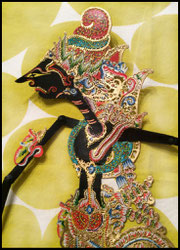
On our most recent visit to Java, friends who live in Solo/Surakarta spoke very highly of Joko Widodo (Jokowi). Jokowi was the mayor of Solo before becoming governor of Jakarta -- and now a presidential candidate. They remarked on Jokowi's strong support of the arts (Solo is a significant batik making center), as well as his success with much needed infrastructure projects. Bravo!
The literature major in me is always interested in the power of shared stories -- and in this case proffering a glimpse of what the future might hold for Indonesia.
Wayang kulit: Cultural treasure past and present
Environmental Stewardship

Pak Hendri is an inspiration: Knowledgeable, motivated, articulate, and incredibly productive. His is a great story that will take more than a blog post to tell.
Pak Hendri is an environmental steward in a country where environmental issues are not necessarily foremost in the minds of the 55,000+ small and medium sized batik makers - or the textile industry as a whole. A reasearcher, chemist and forward thinking former member of the Ministry of Batik and Handicraft, he now travels the country helping SME's to better understand the implications of chemical dyes, and the opportunities associated with natural, plant based dyes. Pictured here with bixa (annatto), a plant whose seeds are well known for their use as a natural yellow or orange colorant. (Video credit to Gabrielle Thibaudeau)
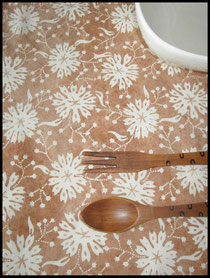
In our current collection of tabletop linens we are featuring both designs created in collaboration with Pak Hendri in his workship in Jogjakarta, as well as some batiks designed and dyed by some of his (many) students. This large floral block print is from a batik workshop in Solo, where they now incorporate natural dyes in their work after taking Pak Hendri's "Go Green" seminar.
Thanks to Fiber Art Now for featuring Textiil's natural dye batiks in their Earth Day feature on Facebook, and also to our partner 1% for the Planet for giving us a shoutout on their Facebook page. More designs and more color choices coming!
Go! --> Borobudur
There are so many outstanding places to visit for so many different reasons -- and this World Heritage site is undoubtedly on many a list. About 25 miles (an hour plus) outside of Jogjakarta is Borobudur, the largest Buddhist monument in the world. Many local tours suggest leaving at 3, 4 or 5 am to be there for sunrise. Okay. But if you leave at the more reasonable hour of 6 am – don’t feel like you are missing out. Take the back roads and you’ll see morning in the countryside, some rice paddies and smaller villages -- a perfectly beautiful way to start the day.
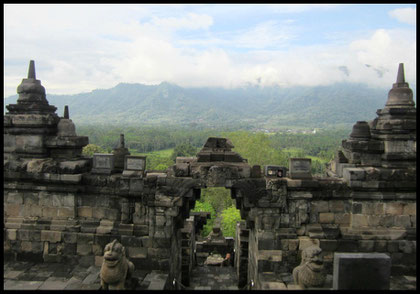
When we arrived at Borobudur around 7:15am there were no crowds at all. (Note: it was a weekday). As you pay for your ticket you are asked if you would like a guide. It is great to have a guide to accompany you. And if you’d like an English speaking guide there will be one available. Our guide was knowledgeable and full of information about the monument -- but blended that discussion well with information about life in general in Indonesia. He explained a good selection of the carved reliefs regarding the life of Buddha and the general history and the logic of the construction – based on the seven stages of enlightenment. He also recommended places where the photographs might best.
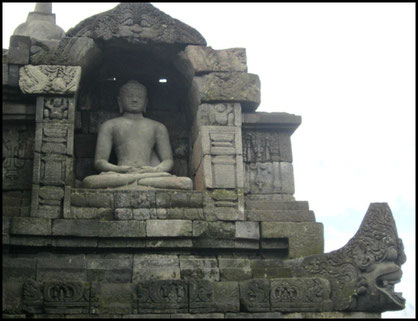
In a nutshell here is a description of the site using a passages from UNESCO. (A “stupa” is a beautiful form that looks like an upside down bell):
The vertical division of Borobudur Temple into base, body, and superstructure perfectly accords with the conception of the Universe in Buddhist cosmology. It is believed that the universe is divided into three superimposing spheres, kamadhatu, rupadhatu, and arupadhatu, representing respectively the sphere of desires where we are bound to our desires, the sphere of forms where we abandon our desires but are still bound to name and form, and the sphere of formlessness where there is no longer either name or form. At Borobudur Temple, the kamadhatu is represented by the base, the rupadhatu by the five square terraces, and the arupadhatu by the three circular platforms as well as the big stupa. The whole structure shows a unique blending of the very central ideas of ancestor worship, related to the idea of a terraced mountain, combined with the Buddhist concept of attaining Nirvana.
http://whc.unesco.org/en/list/592
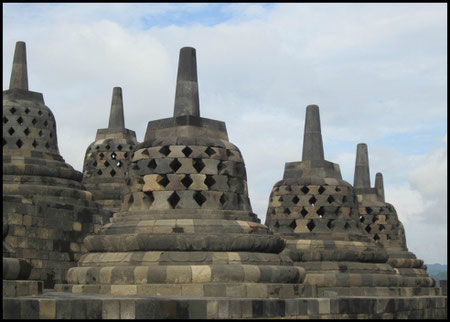
The story of Borobudur is long. It includes periods of disinterest, decay, ruin, rediscovery and rebuilding. In it’s current state, the marriage of function and form is stunning. The experience of ascending to a place designed to be at once more simple and more complete, was a remarkable experience. Highly recommended. Hope you can → GO!
Warna Alam - Natural Color Batik
Back from Indonesia and delighted to have met with Pak Hendri -- a wonderful teacher, researcher, businessman and friend to many. He has been developing, tinkering with, and promoting the use of natural dyes for the batik industry in Indonesia for over 15 years. We have a selection of fabric from his workshop for sale by the yard, as well as some designs from one of his many students. Fine artist Amanda McCutcheon and I spent the day working with him on designs for tabletop linens and a series of silk batiks for Textiil's first collection of men's ties. I look forward to sharing them with you!
Color of the Year?
The batik shop in Solo that makes the fabric for one of our best sellering pillows, the red, orange and yellow stripe batik also makes this purple stripe. In celebration of Radiant Orchid, the Pantone color for 2014, we are stocking this wonderful painterly stripe that runs from maroon, to blue, to purple -- including a bit of orchid purple. It looks radiant to me! Available by the yard.
Borders and Batik
It was great fun to read “Bordering on Genius” in the Wall Street Journal.
Courtney Barnes, who writes the StyleCourt blog talks about her love of
“fabrics with frames” and she speaks with several textile designers about why and how they use borders in their fabrics.

One of the beautiful things about many Indonesian batiks is that they incorporate a border pattern in the fabric. It plays out in a number of different ways: Sometimes the border runs along one side only, and sometimes there is a border around the whole piece of fabric or sarong. Sometimes there is a border on either end, and sometimes it is different from the side borders. Because many of the batiks are designed to be worn, the pattern works as part of, or has meaning with respect to, the dress. The borders are intricate and beautiful in their own right, which adds to the pleasure of looking closely at the whole cloth.
When the batiks are used as tabletoppers, the borders give a finished look to the set table; when they are used as wall panels, one has the choice of featuring the border at the top or the bottom of the panel; and for pillows, you can incorporate the border or choose not to use it at all!

Batik Motif - Sido Wirasat
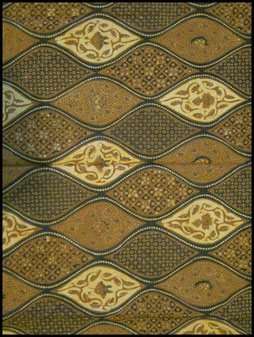
At home, I have used this pattern for a handsome pair of lumbar pillows, but this batik has true significance as a Javanese wedding motif. You can see this image in more detail on Pinterest (along with other beautiful batiks), or mouse over to see the patterns within the pattern. One of them is made up of tiny stars on a black background. This Truntum pattern is broadly used in batik and can be found on its own, or incorporated with other motifs. It is often worn in some form by the parents of a wedding couple as it signifies love that grows and blossoms again. But that is only part of this larger motif sido wirasat.
Though there are variations in interpretation, this sido wirasat pattern is a pattern worn by the parents of a wedding couple. As - sido meaning continuously, and wirasat meaning advice or counsel - It is believed that the parents are in the position to provide good counsel to the wedding couple as they enter into their new life together.


